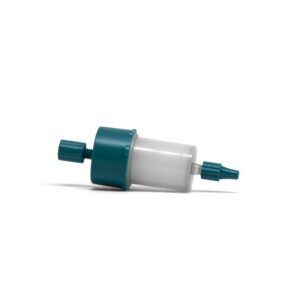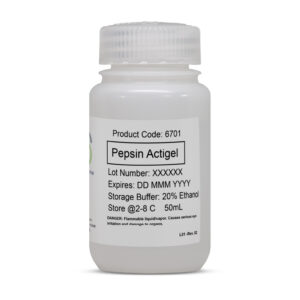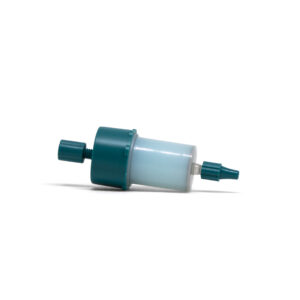Table 1. Resin Characteristics
| Bead Material
| Agarose |
| Bead Percentage
| 4% |
| Bead Size | 60-160 µm |
| Flow Rate1 | >30 mL/min (>1020 cm/hr) @ 25oC |
| Binding Capacity (static) | > 50mg/mL |
| pH Stability | 3-13 |
| Storage Temperature | 2-8o C |
| Storage Buffer
| 20% Ethanol |
| Form | Slurry |
| Chemical Stability2 | Stable in all commonly used aqueous solutions and buffers. |
| Physical Stability2 | Negligible volume variation due to changes in pH or ionic strength. |
1Linear flow rate = volumetric flow rate (cm3/h)/column cross-sectional area (cm2)
2Data refer to the coupled product, provided that the ligand can withstand the pH or chemical environment. Please note the following: pH stability, long term refers to the pH interval where the medium is stable over a long period of time without adverse effects on its subsequent chromatographic performance. pH stability, short term refers to the pH interval for regeneration and cleaning procedures.
Protein-A chromatography is one of the most widely used method to purify polyclonal and monoclonal immunoglobulin G IgGs. Sterogene Protein A Superflow 4 is a highly specific and stable affinity resin for one-step purification of immunoglobulins (IgGs) from several species and can be purified from any biological samples or expressed mediums. Purified rProtein A is covalently coupled to our Superflow 4 resin using epoxy chemistry. The coupling is highly stable and shows no leaching with commonly used buffers or 0.1N NaOH used in CIP. Sterogene’s Protein A resin has a high static binding capacity (50 mg of IgGs/mL of resin) and can used multiple times without any significant loss in the yield.
Protein A is a cell wall protein present in Staphylococcus aureus, a gram-positive bacterium, it contains five homologous immunoglobulin binding domains (E-D-A-B-C). The recombinant Protein A contains five native domains followed by a cysteine residue for directional coupling on the epoxy-activated Superflow 4 resins. Sterogene’s Protein A Superflow 4 is an ideal resin for the purification of polyclonal or monoclonal IgGs antibodies from human, mouse, rat, dog, cat, pig, rabbit, and Guinea pig. Protein A has high affinity for different subclasses of IgGs from human (IgG1, IgG2 and IgG4), mouse (IgG2a, IgG2b and IgG3), and rat IgG2c.
Sterogene Protein A Superflow 4 resin has the flexibility to be used in different formats. It can be packed in FPLC compatible columns for large scale automated purification on various FPLC systems. It can also be packed in manual columns for small scale purification by gravity-flow and can be used for immunoprecipitation studies.
Protein A Superflow 4 is supplied as 50% slurry containing 0.02% sodium azide.
Store the resin at 4 °C upon receiving. Do not freeze.
Key features:
Matrix support: 4% crosslinked agarose beads
Immobilized ligand: recombinant Protein A (5 IgG binding domains)
Ligand density: 5 mg Protein A/mL of agarose beads
Static Binding capacity: 50 mg of human IgG/mL of resin
Storage buffer: PBS with 0.02% sodium azide.
Elution buffer: 0.1 M glycine, pH 2-3.
Protocol for purification of IgG:
Materials required:
Sterogene Protein A Superflow 4 resin
Disposable columns
Equilibration buffer: 10 mM phosphate buffer with 150 mM NaCl (pH 8.2)
Wash buffer A: 10 mM phosphate with 150 mM NaCl (pH 7.5)
Wash buffer B: 10 mM phosphate buffer with 500 mM NaCl (pH 7.5)
Elution buffer: 0.1 M glycine, pH 3
Neutralization buffer: 1.0 M PBS or 1.0 M Tris (pH 8.0)
Remove the Protein A Superflow 4 resin from 4 °C and equilibrate it at room temperature along with the required buffers. Below is the protocol for purification of IgG from serum using 1 mL of Protein A Superflow 4 in a column.
Pack 2 mL of Protein A Superflow 4 slurry in appropriate disposable column and let the column drain completely.
Wash the beads with 10 mL of equilibration buffer at high flow rate, let the column drain properly.
Dilute the loading sample (1:1) in equilibration buffer and apply to the column at slow flow rate. Check the loading sample for any precipitation after dilution. If required, centrifuge the sample (15000 rpm at room temperature for 15 min) to remove any precipitate and load the clear supernatant to the affinity column.
Wash the column with 10 mL of wash buffer A followed by 10 mL of wash buffer B. Monitor the wash fractions at OD280 for presence of any protein. Additional wash steps can be performed until the baseline is reached.
Elute the bound IgGs with 5 mL of 0.1 M glycine (pH 3.0), elution should be done at slow flow rate and in small fractions (500 µl).
Immediately neutralize the acidic pH of the eluted samples to physiological pH by adding 50 µl of neutralization buffer to each fraction and check their OD280 to calculate the IgG concentration.
Run all the fractions on SDS-PAGE to check the purity/homogeneity of the eluted protein, pool all the pure fractions and dialyze in the required buffer.
The Protein A Superflow 4 column can be regenerated by washing with 20 mL of wash buffer B and can be further used multiple times (>10 times) without loss of any significant activity.
For storage, wash the beads with 5 mL of deionized water containing 0.2% sodium azide and store the column at 4 °C with 2-3 mL of same 0.02% sodium azide solution.
To Download Instructions for use:
Instructions for use 937609SF4 Protein A Superflow 4_922



